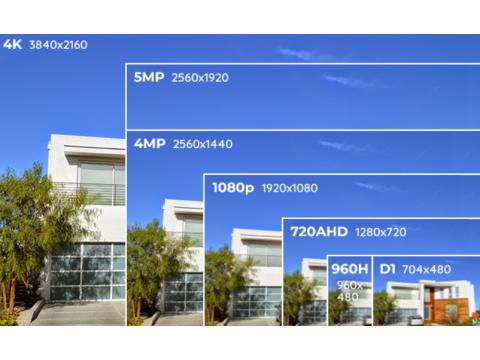Surveillance Camera Resolution: The Key to Image Quality
Resolution is a critical factor in determining the clarity and detail of video footage captured by surveillance cameras. It influences how well objects and individuals can be identified in the camera's field of view.
Understanding Resolution for Analog Cameras
Traditional analog cameras measured resolution in TV lines (TVL):
- Standard: 380-420 TVL (~500 horizontal pixels).
- High: 560-600 TVL (~750 horizontal pixels).
- Some advanced models: 1000 TVL.
Modern analog formats like AHD, CVI, and TVI now report resolution in pixels, aligning with digital standards.
Resolution for IP Cameras
- IP cameras define resolution as the product of the horizontal and vertical pixels on the camera’s sensor.
- Examples include:
- HD 720p: 1280 x 720 pixels.
- Full HD 1080p: 1920 x 1080 pixels.
- 4K UHD: 3840 x 2160 pixels.
- 8K UHD: 7680 x 4320 pixels (used in professional settings).
The aspect ratio (e.g., 16:9) affects the total pixel count and viewing experience.
Impact of Resolution on Video Quality
Higher resolution improves:
- Detail and clarity.
- Ability to zoom in for analysis.
- Realistic image reproduction.
Distance from the camera and field of view also influence image detail:
- Objects closer to the camera appear more detailed.
- Adjusting the camera's angle of view or using a varifocal lens can optimize detail for specific areas.
What Is HD Quality?
- HD (High Definition): A standard for sharp, detailed video.
- 720p (1280 x 720 pixels): Entry-level HD standard.
- Often used interchangeably with broader "high-resolution" formats.
What Is Full HD (FHD)?
- Full HD (1920 x 1080 pixels):
- Includes over 2 million pixels (2 MP) for superior clarity.
- Popular in systems requiring precise detail, such as:
- License plate recognition.
- Facial identification.
- Large-scale monitoring.
Choosing the Right Resolution
Considerations for selection:
- Purpose: High-detail tasks like facial recognition require higher resolution.
- Budget: Higher resolution cameras are more expensive and require more storage.
- Bandwidth: High-resolution video demands more network resources.
Use online tools like resolution calculators to determine optimal settings for your needs.
Conclusion
Resolution is a cornerstone of effective surveillance. HD (720p) and Full HD (1080p) standards offer scalable solutions for diverse applications, balancing cost and performance. Higher resolutions like 4K or 8K are suited for specialized scenarios requiring exceptional detail. Always align camera resolution with the specific demands of your security setup.

